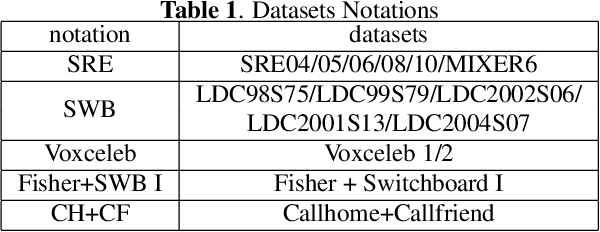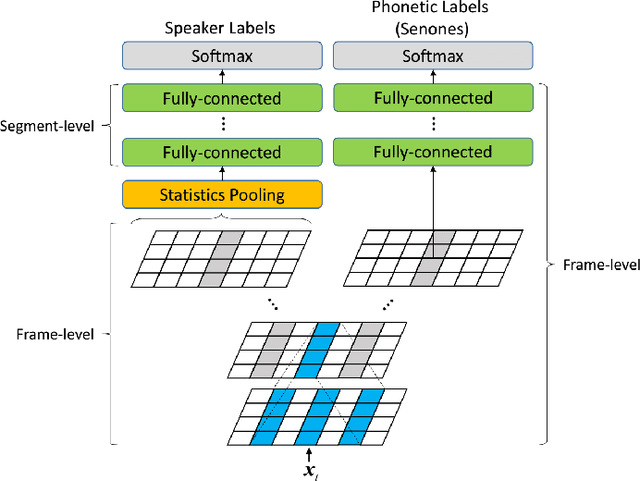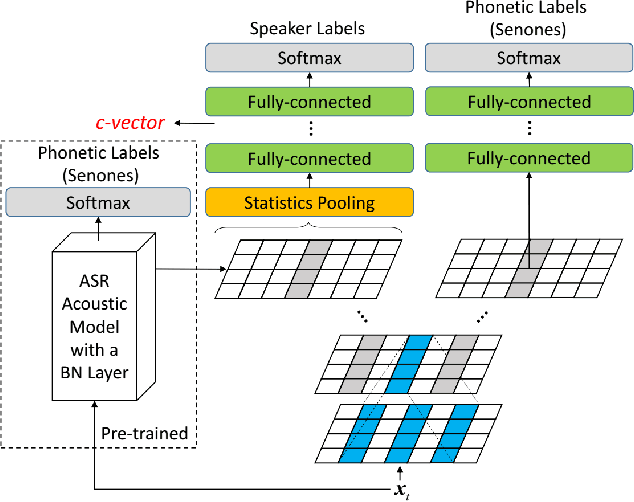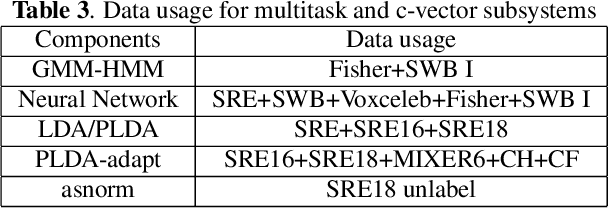Jinghan Peng
THUEE system description for NIST 2020 SRE CTS challenge
Oct 12, 2022



Abstract:This paper presents the system description of the THUEE team for the NIST 2020 Speaker Recognition Evaluation (SRE) conversational telephone speech (CTS) challenge. The subsystems including ResNet74, ResNet152, and RepVGG-B2 are developed as speaker embedding extractors in this evaluation. We used combined AM-Softmax and AAM-Softmax based loss functions, namely CM-Softmax. We adopted a two-staged training strategy to further improve system performance. We fused all individual systems as our final submission. Our approach leads to excellent performance and ranks 1st in the challenge.
The SpeakIn Speaker Verification System for Far-Field Speaker Verification Challenge 2022
Sep 23, 2022

Abstract:This paper describes speaker verification (SV) systems submitted by the SpeakIn team to the Task 1 and Task 2 of the Far-Field Speaker Verification Challenge 2022 (FFSVC2022). SV tasks of the challenge focus on the problem of fully supervised far-field speaker verification (Task 1) and semi-supervised far-field speaker verification (Task 2). In Task 1, we used the VoxCeleb and FFSVC2020 datasets as train datasets. And for Task 2, we only used the VoxCeleb dataset as train set. The ResNet-based and RepVGG-based architectures were developed for this challenge. Global statistic pooling structure and MQMHA pooling structure were used to aggregate the frame-level features across time to obtain utterance-level representation. We adopted AM-Softmax and AAM-Softmax to classify the resulting embeddings. We innovatively propose a staged transfer learning method. In the pre-training stage we reserve the speaker weights, and there are no positive samples to train them in this stage. Then we fine-tune these weights with both positive and negative samples in the second stage. Compared with the traditional transfer learning strategy, this strategy can better improve the model performance. The Sub-Mean and AS-Norm backend methods were used to solve the problem of domain mismatch. In the fusion stage, three models were fused in Task1 and two models were fused in Task2. On the FFSVC2022 leaderboard, the EER of our submission is 3.0049% and the corresponding minDCF is 0.2938 in Task1. In Task2, EER and minDCF are 6.2060% and 0.5232 respectively. Our approach leads to excellent performance and ranks 1st in both challenge tasks.
The SpeakIn System Description for CNSRC2022
Sep 22, 2022



Abstract:This report describes our speaker verification systems for the tasks of the CN-Celeb Speaker Recognition Challenge 2022 (CNSRC 2022). This challenge includes two tasks, namely speaker verification(SV) and speaker retrieval(SR). The SV task involves two tracks: fixed track and open track. In the fixed track, we only used CN-Celeb.T as the training set. For the open track of the SV task and SR task, we added our open-source audio data. The ResNet-based, RepVGG-based, and TDNN-based architectures were developed for this challenge. Global statistic pooling structure and MQMHA pooling structure were used to aggregate the frame-level features across time to obtain utterance-level representation. We adopted AM-Softmax and AAM-Softmax combined with the Sub-Center method to classify the resulting embeddings. We also used the Large-Margin Fine-Tuning strategy to further improve the model performance. In the backend, Sub-Mean and AS-Norm were used. In the SV task fixed track, our system was a fusion of five models, and two models were fused in the SV task open track. And we used a single system in the SR task. Our approach leads to superior performance and comes the 1st place in the open track of the SV task, the 2nd place in the fixed track of the SV task, and the 3rd place in the SR task.
 Add to Chrome
Add to Chrome Add to Firefox
Add to Firefox Add to Edge
Add to Edge